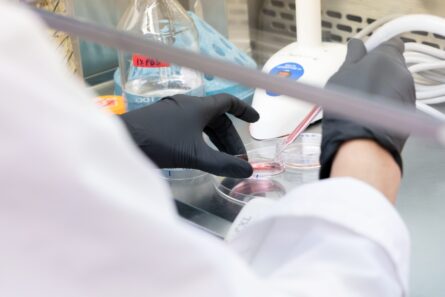
Driven by the rare disease’s impact in Quebec, researchers at McGill University are working to transform lab discoveries into clinical applications
Research at McGill University has brought promising developments in gene therapy targeting a rare hereditary disease present in Quebec.
Initially identified in the Charlevoix and Saguenay regions in 2000, Autosomal Recessive Spastic Ataxia of Charlevoix-Saguenay (ARSACS) significantly affects motor control and co-ordination, and causes stiffness, particularly in the legs. This condition first appears in children ages two to five and progresses slowly. Though rare, affecting only one in 1,500 people in the region and with roughly 320 cases in Quebec, ARSACS is increasingly recognized globally as the second most common form of ataxia.
The limited number of people affected by ARSACS often makes generating interest from pharmaceutical companies a significant challenge. However, the Quebec and Canadian governments recently have begun to prioritize research on rare diseases, including ARSACS; this aligns with the ongoing efforts of researchers such as Benoit Gentil, an Associate Professor in the Department of Kinesiology and Physical Education at McGill University.
Research efforts and innovative solutions in gene therapy
 Interested in diseases affecting nerves and mobility, Gentil and his research group aim to better understand ARSACS, driven by its impact in Quebec. Their research has been supported for several years by the Ataxia Charlevoix-Saguenay Foundation and has led to promising developments in gene therapy.
Interested in diseases affecting nerves and mobility, Gentil and his research group aim to better understand ARSACS, driven by its impact in Quebec. Their research has been supported for several years by the Ataxia Charlevoix-Saguenay Foundation and has led to promising developments in gene therapy.
“ARSACS is caused by a single gene called SACS,” said Gentil. “We’ve developed a gene therapy that targets the root cause of the disease and aims to restore the affected gene’s function.”
In gene therapy, the goal is to treat or prevent diseases by introducing new or modified genes into a patient’s cells, which are delivered through modified viruses, called “vectors.” The use of vectors ensures that the genetic instructions reach the target cells safely, efficiently and in a controlled way to minimize side effects.
“The challenge with ARSACS is that the affected gene is too large to fit into the vector we use,” explained Gentil. “To solve this, we created a ‘mini gene’ (which we call ‘mini-SACS’) by finding and using only the essential parts of the gene needed to fight the disease.” This method is similar to the ones used for other genetic disorders, like Duchenne muscular dystrophy.
“Early studies have shown that we can delay the onset of several symptoms of ARSACS in animal models,” said Gentil. “These results encourage us to continue testing to see how effective the therapy can be.”
Support and commercialization
Gentil said his aim is to develop and bring this technology to market. To do this, he sought the support of NeuroSphere, the McGill platform dedicated to innovation and partnership in neuroscience and neuroinformatics research.
In addition to receiving one of NeuroSphere’s Ignite Grants, Gentil and his team received guidance from NeuroSphere in designing experiments that meet U.S. Food and Drug Administration (FDA) requirements to ensure that the team had the necessary data for regulatory approval, to speed up the regulatory approval process.
“The strategic guidance offered by NeuroSphere has been invaluable in transitioning our research from the lab to clinical applications,” said Gentil. “They helped us navigate aspects of intellectual property, explore partnerships with pharmaceutical companies and even potentially start a company.”
NeuroSphere recently announced a strategic partnership with the Ataxia Charlevoix-Saguenay Foundation, with each group committing $200,000 to support Gentil’s research. Adrienne Crampton, Associate Director of Business Development at NeuroSphere, said that Gentil’s project stands out for its potential to make a strong impact in its field.
“While working with Gentil’s team in the earlier stages of their research, we were impressed with their dedication and meticulous approach. Their work not only pushes the boundaries of what is possible in gene therapy for ARSACS, but also exemplifies the core mission of NeuroSphere: to drive forward transformative medical breakthroughs,” said Crampton. “By supporting projects like this, we’re investing in a future where innovative research translates into real-world clinical applications, offering hope and improved outcomes for patients.”
Learn more about Ataxia Charlevoix-Saguenay:
Read more about Benoit Gentil’s research:
